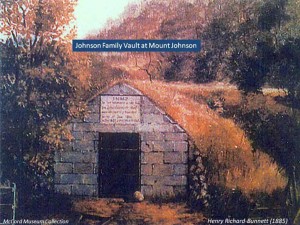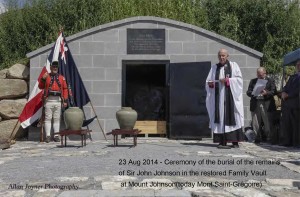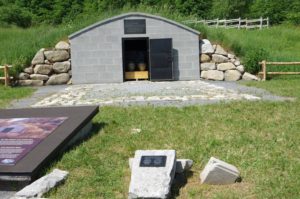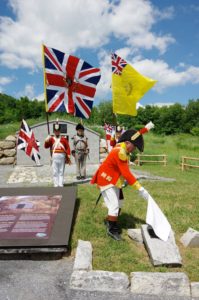Sir John Johnson, the only (legitimate) son of Sir William Johnson and Mary de Weissenberg, was born on 4 Nov 1741 at Johnstown, in the Mohawk Valley, Province of New York.

During the Seven Years War, at age 13, John accompanied his father and took part as a volunteer in the Battle of Lake George, where the French troops were defeated in 1755, and he was only seventeen years old when he took part at the Siege of Fort Niagara. In 1759, he was a Cadet and in 1763, a Captain in the New York Provincials. For their effort in taking an active part in the French and Indian War, from 1755 to 1763, William Johnson received a baronetcy and John was promised a knighthood when he became 21. In 1765 at the age of 23, John was knighted for his services.

Sir John married Mary Watts, daughter of John Watts, President of Council of Colonial Affairs in New York City. They had 11 children. Sir John succeeded to the Baronetcy on the death of his father in 1774, becoming the Second Baronet of New York. He inherited vast properties, including Johnson Hall, all of which he had to leave when forced to flee to Canada in 1776.

When the hostilities erupted in the British colonies, Sir John was Major General, Northern District, New York Militia. But Sir John remained loyal to the King forcing him to escape to avoid capture by the rebel troops. When he arrived in Montreal in 1776, Sir John was commissioned to raise a regiment of Loyalists. As Lieutenant Colonel Commandant he formed the King’s Royal Regiment of New York, also called the Royal Greens, ultimately comprising two battalions. His troops made frequent raids into the Mohawk Valley to rescue other Loyalists and to wreck havoc among the rebels, defeating the Americans at the Battle of Oriskany in 1777. On 14 March 1782, he was appointed Superintendant and Inspector General of Indian Affairs in British North America. That same year, he was made Brigadier General of Provincial Troops.
It was Sir John who was assigned the task of settling the Loyalists into their new homes. On 17 May 1784, he was named Superintendant General of Refugee Loyalists. He organized and supervised the settlement of the Loyalists on the upper St. Lawrence and the Bay of Quinte, establishing himself and others in Kingston, Gananoque, Williamstown and New Johnstown, later renamed Cornwall.

Sir John Johnson is considered one of the foremost United Empire Loyalists in Canada. He continued until shortly before his death, to be Superintendant of Indian Affairs, and a figure of great social, commercial and political influence in Lower Canada. Appointed Legislative Councillor from 1786 to 1791, he was recommended to be Upper Canada’s first Lieutenant Governor, a position that unfortunately escaped him. However, following the formation of the two provinces, he was reappointed to the Legislative Council of Lower Canada in 1796.
When the War of 1812 broke out, Sir John had been, since 1804, Colonel Commandant of the Eastern Townships Militia, comprising at that time six battalions which contributed militiamen to the Battalions of Select and Embodied Militia and to a Corps which fought with the Canadian Voltigeurs. Even though he was a man of more than seventy, his leadership and experience were of great value. His letter to George Prevost (in the museum at Crysler Battlefield Memorial Park) shortly before the actual outbreak of war, is a masterpiece of advice as the best way of using the Rangers and Indians in what was to be the coming campaign.
On 19 Feb 1813, Governor George Prevost sent the following letter to Colonel Sir John Johnson, the commander-in-chief of the Eastern Townships Militia battalions:
“Sir, I have to desire that you will take immediate measures for calling into service One Hundred and Twenty Men, from the Six Township Battalions of Militia, under your command; these men are to serve under the Militia Law, and are not to remain embodied more than one year, unless the greatest emergency should render the continuance of their services indispensably necessary. I am Sir, Your Most Obedient Humble Servant, George Prevost”
Although very much undervalued, the participation of the Indians in the War of 1812 in both Upper and Lower Canada under Johnson’s Superintendence played an important part in the outcome. It was Sir John himself who dispatched the detachment of Indians that were at the victory of the Beaver Dams (24 June 1813) as well as at the Battle of the Chateauguay (26 Oct 1813).
Eight of Sir John’s sons served in His Majesty’s Armed Forces, six of them during the War of 1812, two of whom gave up their lives to the cause (Robert in Canada and James at Badajoz against Bonaparte’s forces). William Claus assisted Johnson with the Indians in the Niagara region and brother-in-law Edward McDonnell served as Deputy Quarter-Master General until his death in October 1812. Son-in-law Major General Bowes (married to Maria), wounded at Badajoz was later killed in Spain during the same campaign.
Like his father had done in the Mohawk Valley and despite the loss of that considerable inheritance to the American Revolution, Sir John helped settle and develop large tracts of land in both Upper and Lower Canada. Builder of grist and saw mills in Upper Canada, Sir John did likewise as Seignior of Monnoir and Chambly East (on the east-side of the Richelieu River) and in Argenteuil (west of Montreal and north of the Ottawa River).

Sir John promoted, supported and endowed numerous congregations and parishes, some with lands, some with gifts such as bells to adorn church belfries. He did the same for schooling with land grants and by his support of the Royal Institution for the Advancement of Learning. He participated as well in the works of the Quebec Agricultural Society and in the regulation of internal navigation for Montreal. Owner of a large and commodious house on St. Paul Street sold to his long-time friend and fellow Mason, John Molson, it became the luxurious Mansion House Hotel. The eastern portion of the Bonsecours Market occupies the site today.
Sir John “departed this Life on the 4th January 1830 in the 88th year of his age” as is inscribed on his tombstone. His funeral, at the original Christ Church Cathedral in Montreal, performed by the Reverend Mr. Stevens, Chaplain of the Forces, was largely attended by friends and relatives, members of the Masonic Lodges in their regalia (Sir John Johnson had been Provincial Grand Master) and several hundred Indians. His grand funeral procession, which included the 24th Regiment and Band, paraded to a landing where a boat was waiting to convey his remains across the St. Lawrence River for interment in the family vault on Mount Johnson (now known as Mont Saint-Grégoire), where the remains of his wife, two sons (William and Robert) and his brother-in-law (Edward) awaited him. Later, two other sons joined them (John Junior and Sir Adam Gordon). The vault is located near the Village of Mont-Saint-Grégoire, not far from Saint-Jean-sur-Richelieu. Demolished in the 1950s, the vault has now been restored and re-dedicated (2014) as part of the Centennial celebrations of the United Empire Loyalists’ Association of Canada and is available to be visited by the public.
Veteran Summary
Sir John JohnsonColonel, Six Township Battalions of Militia, Eastern Townships, Lower Canada
Place of Birth
Johnstown, Mohawk Valley, New York, USA
Place of Death
Montreal, Quebec, CAN
Died on: 04 JAN 1830
Reason: Natural death
Location of Grave
Johnson Family Vault, 16 Chemin du Sous-Bois
Mont-Saint-Grégoire, QC, CAN
Latitude: 45.350785N Longitude: -73.148232

